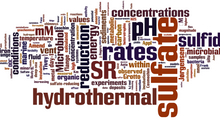Hot off the Press: New paper on survival of Staphylococcus aureus in turbid waters
- kianalfrank
- Sep 5, 2023
- 3 min read
In the world of scientific exploration, the journey from a humble undergraduate project to a groundbreaking research paper is often a fascinating one. Such is the case with the recent publication by graduate student Maria Steadmon and her summer undergraduate mentees. Their research, titled "Effects of water turbidity on the survival of Staphylococcus aureus in environmental fresh and brackish waters," sheds light on a crucial aspect of environmental microbiology with profound implications for public health.

The journey of this research began with an summer REU project by Kebang Ngiraklang, who embarked on a project often with the assistance of Macy Nagata and Keke Masga. Little did they know that their initial curiosity would evolve into an important and novel study study resulting in a paper accepted for publication in the prestigious journal "Water Environment Research."
Understanding Staphylococcus aureus in Environmental Waters
Staphylococcus aureus is an opportunistic pathogen that is frequently found in environmental waters. This bacterium is known to cause skin infections in individuals who come into contact with contaminated water sources. Importantly, the concentration of Staphylococcus aureus in various types of water, including fresh, brackish, and marine waters, has been found to be positively correlated with water turbidity. To mitigate the risk of Staphylococcus aureus infections stemming from environmental waters, it is crucial to investigate the bacterium's survival, stability, and multiplication in turbid water conditions. This was precisely the aim of Maria Steadmon's research, and the results have unveiled some eye-opening insights.
Key Findings of the Study
The research team collected a total of eighteen water samples from fresh and brackish sources located on the east side of Oʻahu, Hawaiʻi. They used standard microbial culturing techniques to detect and study Staphylococcus aureus in microcosms over a period of up to 71 days.
Here are the key findings:
Turbidity Matters: The study revealed that the highest concentrations of Staphylococcus aureus were observed in high turbidity freshwaters, followed by high turbidity brackish waters. Turbidity, or cloudiness in water, was a significant factor influencing the bacterium's presence.
Salinity and Turbidity Predict Concentrations: Statistical models demonstrated that both salinity and turbidity significantly predicted the concentrations of Staphylococcus aureus in the environment. This suggests that these two factors play a crucial role in determining the bacterium's survival.
Enhanced Persistence in Turbid Waters: Perhaps the most striking finding was that Staphylococcus aureus persistence was the greatest in high turbidity microcosms. In the absence of sunlight, these conditions led to significantly extended persistence of Staphylococcus aureus communities. In brackish waters, the T90 (time for a 90% reduction) was an impressive 147.8 days, while in freshwaters, it was 80.8 days. This prolonged persistence in turbid water raises concerns about the increased risk of exposure to Staphylococcus aureus in environmental waters.
Implications for Public Health
Maria Steadmon's research highlights the complex interplay between environmental factors and the survival of Staphylococcus aureus. The findings underscore the importance of considering water turbidity and salinity in managing the risk of Staphylococcus aureus infections associated with water use.
This groundbreaking work not only showcases the dedication and collaborative spirit of budding scientists but also serves as a significant contribution to our understanding of environmental microbiology. As we await the publication of the full research paper, one thing is clear: Maria Steadmon and her team have taken a giant leap toward safeguarding public health by unraveling the mysteries of Staphylococcus aureus survival in our waters. Their dedication and insights will undoubtedly leave a lasting impact on the field of microbiology and beyond.























Comments